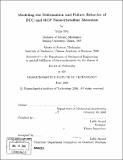| dc.contributor.advisor | Lallit Anand. | en_US |
| dc.contributor.author | Wei, Yujie, Ph. D. Massachusetts Institute of Technology | en_US |
| dc.contributor.other | Massachusetts Institute of Technology. Dept. of Mechanical Engineering. | en_US |
| dc.date.accessioned | 2008-02-28T16:27:45Z | |
| dc.date.available | 2008-02-28T16:27:45Z | |
| dc.date.copyright | 2006 | en_US |
| dc.date.issued | 2006 | en_US |
| dc.identifier.uri | http://hdl.handle.net/1721.1/35626 | |
| dc.description | Thesis (Ph. D.)--Massachusetts Institute of Technology, Dept. of Mechanical Engineering, 2006. | en_US |
| dc.description | Includes bibliographical references (p. 175-188). | en_US |
| dc.description.abstract | As foreseen by Richard Feynman in his famous talk titled There's Plenty of Room at the Bottom in 1959, scientists nowadays are miniaturizing structures in materials to achieve better performance as concerned in technical applications. Reducing grain sizes in polycrystalline materials into the range of less than 100nm, for example, could achieve extraordinary high strength in these so called nanocrystalline (nc) materials. The reduced grain size gives rise to new deformation mechanisms in nc materials. It is now widely accepted that there is a strong interplay between dislocation-based deformation in the crystalline grain interiors and the inelastic deformation mechanisms operative in the grain-boundary regions. Grain-boundary regions play an increasingly significant role as the grain size decreases below the 100nm level. In this dissertation, constitutive models have been developed to investigate the deformation mechanisms of nc materials, with focus on modeling grain-boundary decohesion in nc materials. Two micromechanical models have been developed to capture the deformation in grain boundaries in nc materials. | en_US |
| dc.description.abstract | (cont.) To the end, a phenomenological constitutive model has been developed for powder-processed nc materials, where the plastic flow could be pressure-dependent, plastically-dilatant, and non-normal. To model the deformation in grain boundaries, we made the assumption that the mechanical behavior of a grain boundary is governed by the interaction of two coupled surfaces of neighboring grains. Mechanical response due to the relative sliding and separation between the two coupled surfaces is represented by traction-separation laws. An isothermal, rate-independent elastic-plastic interface model has been developed, which accounts for both reversible elastic, as well as irreversible inelastic separation-sliding deformations at the interface prior to failure. The interface model, which represents the deformation in grain boundaries, is coupled with an isothermal, rate-independent crystal-plasticity model for grain interiors, and to study the deformation and fracture response of nc nickel. Secondly, motivated by the fact that the ultimate size limit for nc materials would be bulk amorphous materials, we treated the non-equilibrium, more or less disordered grain boundaries in nc material as amorphous layers with finite thickness of [approx.] 1nm. | en_US |
| dc.description.abstract | (cont.) A viscoplastic amorphous constitutive model is applied to capture the deformation in grain-boundary regions. The model has been applied to predict the mechanical behavior of nc nickel with different grain sizes and subject to tensile deformation at different strain-rates. Many nanocrystalline materials are made by powder-consolidation; and their macroscopic response is reminiscent of cohesive granular materials. Based on the deformation behavior observed on powder consolidated nc materials from different groups, we have formulated a model for the response of pressure-sensitive and plastically-dilatant elastic-viscoplastic powder consolidated nc materials; where the plastic flow could be pressure-dependent, plastically dilatant, and non-normal. | en_US |
| dc.description.statementofresponsibility | by Yujie Wei. | en_US |
| dc.format.extent | 188 p. | en_US |
| dc.language.iso | eng | en_US |
| dc.publisher | Massachusetts Institute of Technology | en_US |
| dc.rights | M.I.T. theses are protected by copyright. They may be viewed from this source for any purpose, but reproduction or distribution in any format is prohibited without written permission. See provided URL for inquiries about permission. | en_US |
| dc.rights.uri | http://dspace.mit.edu/handle/1721.1/7582 | |
| dc.subject | Mechanical Engineering. | en_US |
| dc.title | Modeling the deformation and failure behavior of FCC and HCP nanocrystalline materials | en_US |
| dc.type | Thesis | en_US |
| dc.description.degree | Ph.D. | en_US |
| dc.contributor.department | Massachusetts Institute of Technology. Department of Mechanical Engineering | en_US |
| dc.identifier.oclc | 76274323 | en_US |
